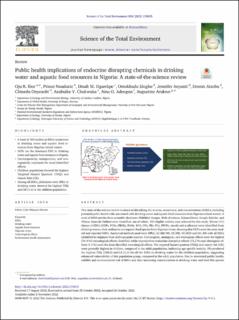| dc.description.abstract | This state-of-the-science review is aimed at identifying the sources, occurrence, and concentrations of EDCs, including potential public health risks associated with drinking water and aquatic food resources from Nigerian inland waters. A total of 6024 articles from scientific databases (PubMed, Scopus, Web of science, ScienceDirect, Google Scholar, and African Journals Online) were identified, out of which, 103 eligible articles were selected for this study. Eleven (11) classes of EDCs (OCPs, PCBs, PBDEs, PAHs, BPA, OTs, PEs, PCs, PPCPs, sterols and n-alkanes) were identified from drinking waters, river sediments and aquatic food species from Nigerian rivers, showing that OCPs were the most studied and reported EDCs. Analytical methods used were HPLC, LC-MS/MS, GC-FID, GC-ECD and GC–MS with all EDCs identified to originate from anthropogenic sources. Carcinogenic, mutagenic, and teratogenic effects were the highest (54.4 %) toxicological effects identified, while reproductive/endocrine disruptive effects (15.2 %) and obesogenic effects (4.3 %) were the least identified toxicological effects. The targeted hazard quotient (THQ) and cancer risk (CR) were generally highest in children, compared to the adult populations, indicating age-specific toxicity. PEs produced the highest THQ (330.3) and CR (1.2) for all the EDCs in drinking water for the children population, suggesting enhanced vulnerability of this population group, compared to the adult population. Due to associated public health, wildlife and environmental risk of EDCs and their increasing concentrations in drinking water and food fish species from Nigerian inland waters, there is an urgent need for focused and strategic interventions, sensitization and policy formulation/implementation towards public health and aquatic food safety in Nigeria. | en_US |

